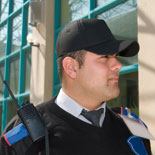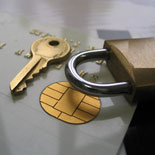Surveiller les allées et venues dans les bâtiments le jour grâce au contrôle d'accès et au contrôle des visiteurs est une chose. on RS485 ou TCP/IP et sont donc plus proches de ceux-ci. Le fait d'avoir un Monitoring comings and goings in buildings during the day using access control and visitor control is one thing. But when all the staff have left the site, anti-intrusion control panels must take up the baton. The advantage of an integrated system like the DBM6000 is that it can be entrusted with the surveillance of the building, zone by zone, as staff depart. Whether in conjunction with access control or through a code or a key, a wide choice of anti-intrusion control panel controls (arming and disarming) is available. This integrated control panel has the capacity to manage 40 partitions, bringing together 1000 detectors. The fully integrated intrusion management modules require, as for a standard control panel, the positioning of movement detec tors which will be connected to the DBM6000 through entry cards (4 states). The standard flash and siren outputs will for their part be managed by relay output cards. The sensors The intrusion sensors can operate according to 9 different modes so as to respond scrupulously to the building's requirements and its layout. For example, panic mode generates a silent priority alarm without activating the sirens, so that intruders do not know that their presence has been detected. Decentralised and therefore modular In this decentralised design, the installer is no longer obliged to bring all the wiring to a single geographical point where the control panel is located. The sensor management cards are distributed on an RS485 or TCP/IP communication bus and therefore are closer to it. Having a modular system makes it easy to modify or extend installations. Link to the supervisor Each sensor can be positioned on the building's levels so as to directly locate where the intrusion has taken place. The interaction between the intrusion and supervisor modules is a perfect illustration of the synergy of the building management techniques which the operators can use. Intervention time as well as methods will therefore be more appropriate for each alarm. | Arming and disarming Starting up or deactivating the control panel offers a very varied range of possibilities. Whether this is: • Using a standard keyboard • In connection with presence in the authorised personnel area • With a key • When there are 3 consecutive passes of the same badge over an access control reader • Through a button on a graphical view of the supervisor • Automatically according to a timetable.
Outputs Signalling the status of the control panel can happen simultaneously in different ways: • Through physical outputs (sirens, flashes, buzzer) • Through graphical animation on the supervisor's synoptic screens • By sending alarms on the supervisor to a mobile telephone or to an electronic surveillance centre (ID contact protocol). The graphics console In addition to the supervisor, an industrial terminal with a colour touch screen shows the status of the various elements (detectors and control panel statuses) | |
- Home
- Solutions
-
Products
- DBM6000
- Autonomous access-control unit DA400
- Access control
- Advanced Security Access Control
- BeeLock
- Managing visitors
- Private parking management
- Impression des badges
- ECO16
- Technical building management
- Managing time
- Energy management
- Integrated Graphic Supervisor
- Infrastructure
- Flowchart
- Anti-intrusion Alarm
- Integrating video monitoring
- Reports
- Management of patrols
- Keys management
- Our readers....
- Dinec
-
News

- Contact





















